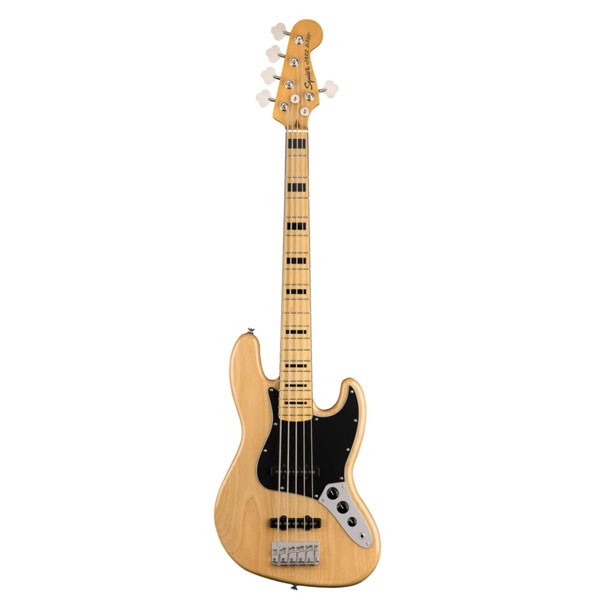Choosing a bass guitar at the under $500 price point isn’t much different than choosing a more high-end one. You’ll need to identify the features that are most important to your playing style. Thankfully, even at this lower price point, there’s a ton of high quality and fully-featured instruments available, and you’ll only have to compromise on the more esoteric materials and hardware.
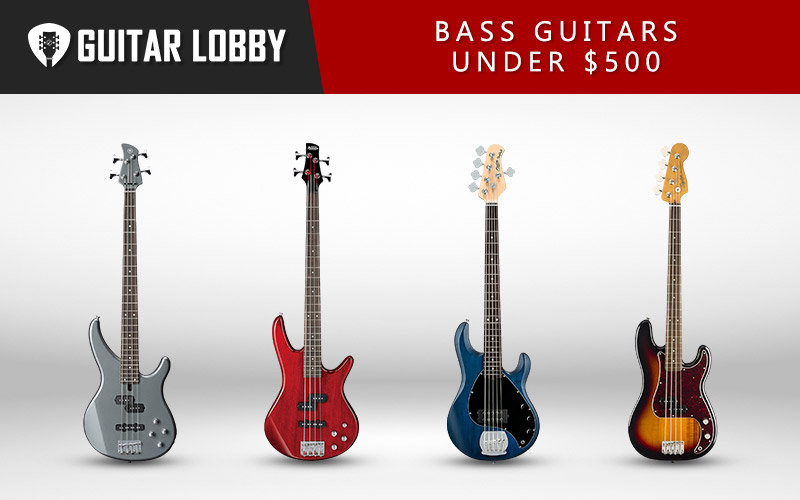
When searching for a bass guitar keep in mind that every element of the bass matters, but some things come down to personal preference. I’ll start this article by helping you find the best bass guitar under 500 dollars for your use cases, but if you’d prefer to do more research before reading reviews, I have also included a buying guide at the bottom of the page that you’ll likely find useful.
| Name of Product | Image of Product | Description | Price Range | Full Review |
|---|---|---|---|---|
| 1. Sterling by Music Man SUB Ray5 | 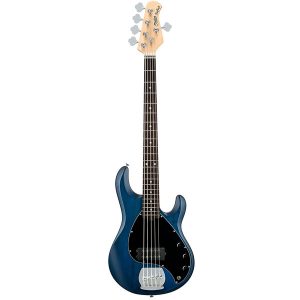 | Materials: Basswood body, maple neck Fretboard: Maple, 21 frets | $350 | Read Full Review Below |
| 2. Yamaha TRBX 305 | 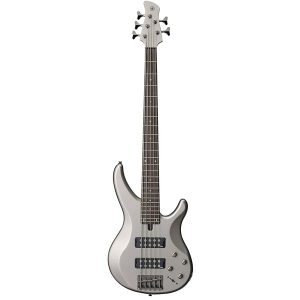 | Materials: Mahogany body, maple/mahogany 5-piece neck Fretboard: Rosewood, 24 frets | $400 | Read Full Review Below |
| 3. Epiphone Toby Standard-IV | 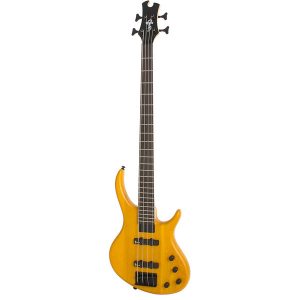 | Materials: Radiata body, maple neck Fretboard: Rosewood, 24 frets | $200 | Read Full Review Below |
| 4. Squier Classic Vibe ’60s Precision Bass | 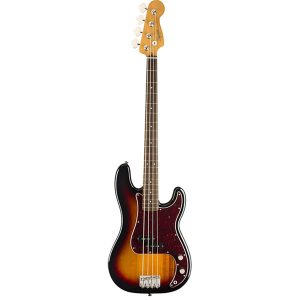 | Material: Poplar body, maple neck Fretboard: Indian laurel, 20 frets | $400 | Read Full Review Below |
| 5. Ibanez GSRM25 | 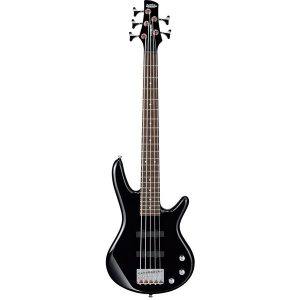 | Materials: Poplar body, maple neck Fretboard: Jatoba, 22 medium-jumbo frets | $450 | Read Full Review Below |
| 6. Squier Classic Vibe ’70s Jazz Bass V | 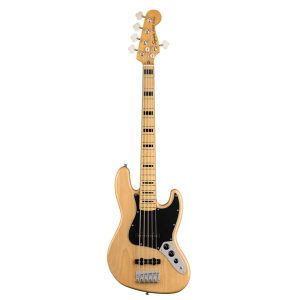 | Materials: Maple body, maple neck Fretboard: Maple, 20 frets | $450 | Read Full Review Below |
| 7. Squier Classic Vibe 60’s Fretless Jazz Bass | 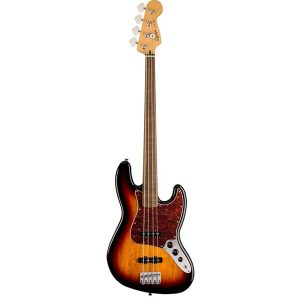 | Materials: Poplar body, maple neck Fretboard: Indian Laurel | $400 | Read Full Review Below |
| 8. Yamaha TRBX204 | 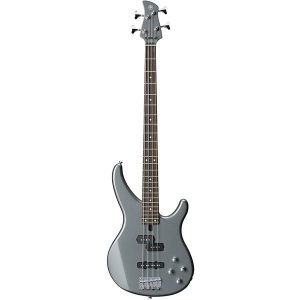 | Materials: Mahogany body, maple neck Fretboard: Rosewood, 24 frets | $300 | Read Full Review Below |
| 9. Ibanez AEB10E | 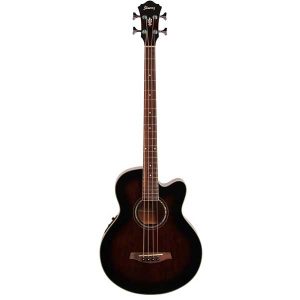 | Materials: Spruce top, mahogany back and sides, mahogany neck Fretboard: Rosewood, 22 frets | $400 | Read Full Review Below |
| 10. Gretsch G2220 Junior Jet II | 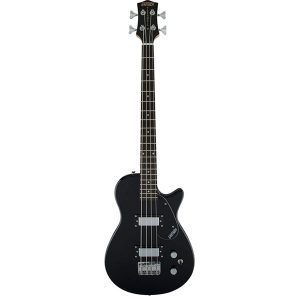 | b Basswood body, maple neck Fretboard: Rosewood, 20 medium jumbo frets | $300 | Read Full Review Below |
| 11. Ibanez GSR 200 | 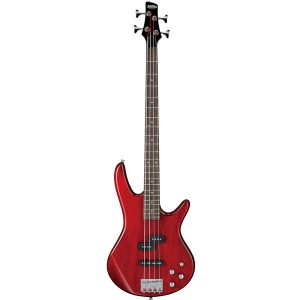 | Materials: Agathis body, maple neck Fretboard: Rosewood, 22 frets | $300 | Read Full Review Below |
Here Are the Best Bass Guitars Under $500
1. Sterling by Music Man SUB Ray5 (Best Value)
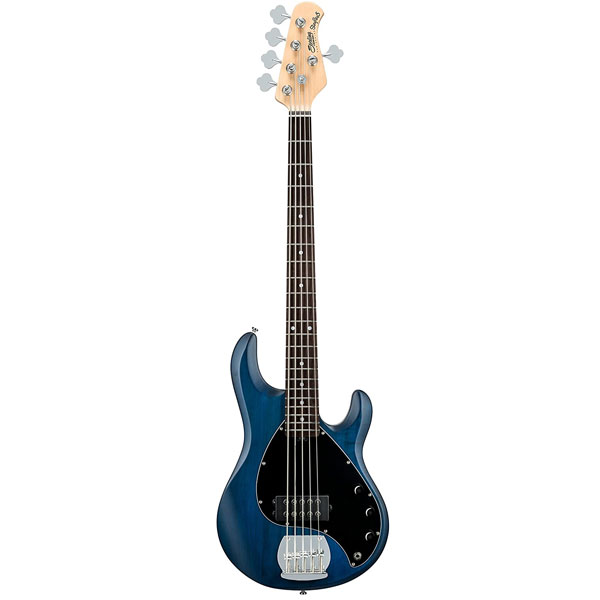
| Estimated Price | $350 |
| Materials | Basswood body, maple neck |
| Fretboard | Maple, 21 frets |
| Pickup Configuration | H-1 ceramic humbucker |
| Scale Length | 34” |
My Review: The SUB Ray 5 feels like a Music Man instrument in every way. The main quality is the robust built that packs a punch for the price. The punchy low end is still there although there is no midrange EQ, and the bass range still performs quite nicely. It has quite a round tone when both EQ settings are set flat which I like very much as it gives the bass that Music Man specific sound. The lower B string can put on quite a display regardless of the lack of midrange EQ, it is deep and wide.
Key Specs and Features: The body is made from basswood while both the neck and the fretboard are from maple giving it that nice bright color. The fret dots are black which I think is a nice contrast with the white satin-finished maple neck. You can find them on the fretboard and the side of the neck. The frets on the fretboard are nice with no sharp ends and the body feels quite comfortable when you strap on the bass. With the basic headstock bias, the style of the bass is what you would expect out of a Music Man bass, a robust and sturdy modern version of a Fender Jazz bass. It’s 9 pounds heavy which is an average weight. The fretboard contains 21 frets and it’s a long-scale (34”). It has a 2 band active EQ which gives the player the freedom to sculpt their tone. The active preamp has controls for volume, bass, and treble which offer maximum flexibility in finding your sound. It has one humbucker that is positioned closer to the bridge that delivers that punchy bright tone.
Target Customer: A good buy for players that gig and travel a lot and need a sturdy instrument that can handle the strains of transport, it can make up for much more expensive instruments with its affordable price and consistent quality. It works well in live or studio space, from jam sessions to live gigs and recordings.
Bottom Line: You can’t make a bad call with this one, for the price range you get a solid instrument that is going to last. It’s not a finesse instrument but it covers that with its playability and performance. Music Man made a bass that is going to satisfy a lot of players. In my opinion, this is the best bass guitar under 500 in terms of overall value.
2. Yamaha TRBX 305 (Best Overall)
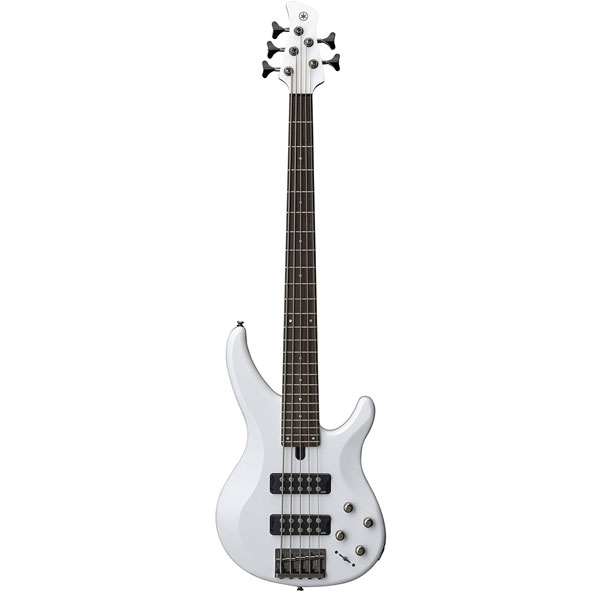
| Estimated Price | $400 |
| Materials | Mahogany body, maple/mahogany 5-piece neck |
| Fretboard | Rosewood, 24 frets |
| Pickup Configuration | 2x MHB3n (Ceramic) |
| Scale Length | 34” |
My Review: Yamaha TRBX 305 is one solid bass, the nice curvy body shape combined with a fine cutaway for fretboard access when soloing makes this bass super playable. It looks sleek and easy to wear, and the finish looks nice. It has a great powerful tone, clean and resonant with a lot of tonal options for you to explore. I think it can do well in most musical areas, it lacks a little finesse but for this price range, it sure does play well and sounds punchy. I like the slap feature it has on its EQ switch, a cool addition that makes the bass stand out a little.
Key Specs and Features: The guitar ways around 12 pounds, which is an above-average weight for a five-string bass. The body is made from mahogany and it has a deep cutaway that looks stylish and has a good function. TRBX uses a precision fitted bolt-on neck joint for maximum adjustability and clear, punchy tone, the 5-piece mixture between maple and mahogany is quite comfortable for faster fingerboard action. It is a long-scale (34”) bass with a smooth rosewood fretboard with 24 frets and it has dots on the fretboard that allow for better playability. It has an active 2-band EQ and a 5-way performance EQ switch which is a unique addition that surprised me, it allows for better tone control and tone creating when playing different musical styles. The 5-way EQ switch has built-in presets for different playing techniques, solo feature, finger, flat, pick and slap. Each one of the presets changes the tone significantly. The two M3 oversized ceramic humbuckers perform quite well and deliver a solid tone without any hum. The pickups also have a built-in thumb rest which is a nice feature.
Target Customer: Yamaha sure does know how to produce quality instruments in the more affordable price range as the Yamaha TRBX305 is an instrument for bass players on an intermediate semi-professional type-level who like to play live, but also studio musicians can find it handy doing sessions.
Bottom Line: Easy to play, good tone controls, looks nice, well balanced, Yamaha TRBX 305 is a perfect buy for the affordable budget, an instrument that is not going to disappoint you.
3. Epiphone Toby Standard-IV (Budget Pick)
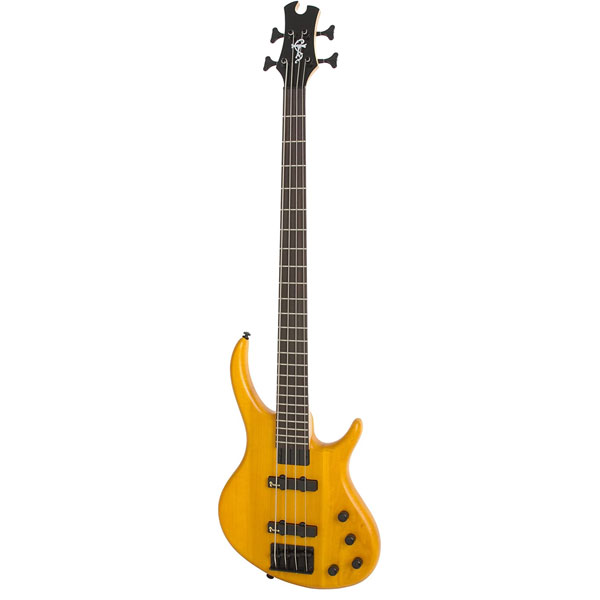
| Estimated Price | $200 |
| Materials | Radiata body, maple neck |
| Fretboard | Rosewood, 24 frets |
| Pickup Configuration | 2x TBT Dual Rail humbuckers |
| Scale Length | 34” |
My Review: This bass came out as a surprise to me considering its price. What is amazing is that it has a bass and treble control, but not active electronics which is awesome for playing those thick metal riffs. It means you can have the tone control of an active bass without worrying about the battery going dead or the electronics simply pooping out at a gig. The smooth and fast neck suits playing fast lines. The Toby Standard IV is a great bass that has that rock/metal vibe going and is playable and fun.
Key Specs and Features: The bass is designed in a very interesting shape, the contours and sleek lines are designed for comfort, but good looks as well. The tonewood, as used by the manufacturer, is pretty rare radiata, though some would say it’s made out of pine. The body is quite light with a nice balance to it. The bolt-on neck made out of maple is somewhat asymmetrical, its thin neck design allows for faster playing. The fretboard of the guitar is made out of rosewood with 24 frets without fret markers and a 34” scale. The fully adjustable bridge provides the bass with some nice string stability, as well as a good level of action and flexibility with sound. The hardware is all black. Toby Standard-IV contains a set of TBT Dual Rail humbuckers that deliver a pretty neat and versatile tone. There are four knobs, master volume control, bass cut, treble cut, and pickup switch.
Target Customer: The Toby Standard-IV has that mean look as well as the sound that you just want to headbang with. This is bass for metal players that are looking to get a pretty neat instrument in the lower price range that is going to last them for a long time, a perfect instrument for young players that are just starting out playing.
Bottom Line: If you are looking for something fancy you won’t find it here. This bass holds its own as one of the best in the range of entry-level bass guitars for music such as rock and metal. It brings a great balance of style, functionality, and great tone.
4. Squier Classic Vibe ’60s Precision Bass
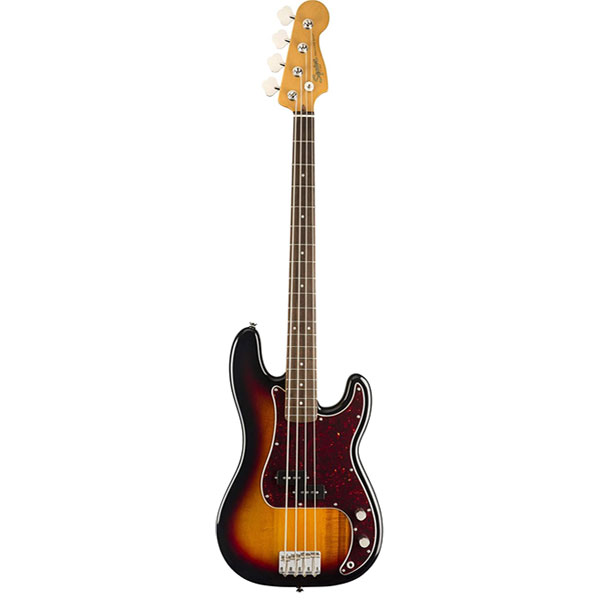
| Estimated Price | $400 |
| Materials | Poplar body, maple neck |
| Fretboard | Indian laurel, 20 frets |
| Pickup Configuration | Fender Designed Alnico Split-Coil |
| Scale Length | 32” |
My Review: Classic Vibe ‘60s is something I always wanted. With the look of the early P-basses and its vintage body you cannot but give this bass some love. It’s sleek and light, playable and it has that old school tone inspired by the ‘60s P-Bass that just brings out another vibe. The punchy fat tone is still there bringing the smooth sound out of you when you play. The body is comfortable, and the C-shape neck fills out the hand and feels just right.
Key Specs and Features: With the comfortable contoured body shape it provides great stability when playing standing or sitting. The body is made out of poplar with a nice vintage gloss finish, while the bolt-on neck is made out of maple with a beautiful Indian laurel fretboard that is something to be desired. It has 20 narrow-tall frets and a long-scale length. The nut is made from a bone that is a nice interesting touch as it transfers the vibrations through the bass. The standard split-coil passive pickup you would expect on a P-bass, Fender yet again found a way to produce that legendary fat punchy tone. Fender specially designed the Alnico pickups for this bass, and it proved to be a nice feature. The 4-Saddle vintage-style bridge with threaded steel saddles points out the P-bass look even more. All of the other hardware is in the style of the P-bass, bridge, and neck control knobs with the master volume knob.
Target Customer: For players who are lovers of that classic P-bass look and sound, and like players such as James Jamerson or Pino Paladino, this is a great buy at an affordable price. Intermediate players who like to play around with different styles of music are going to love this bass, it is perfect for doing live gigs or recording some stuff in the studio.
Bottom Line: As a P-bass lover myself I can tell you this is a solid bass that goes beyond the expectations considering the price. Squier ‘60s P bass is a solid alternative to the more expensive Fender P-bass that still holds its own considering the price.
5. Ibanez GSRM25
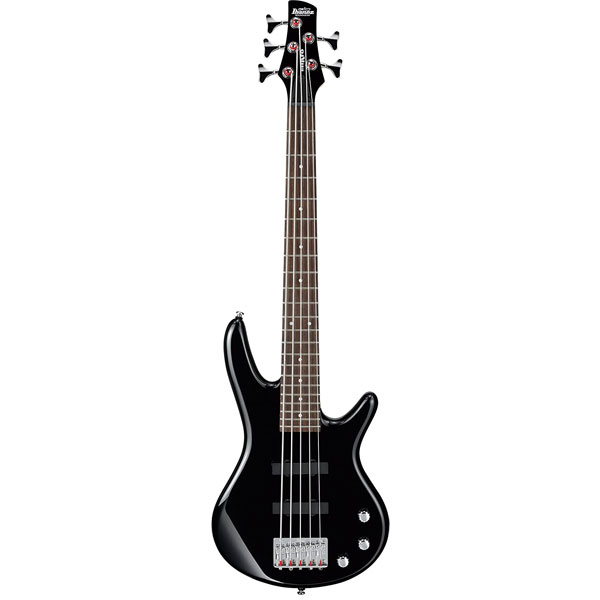
| Estimated Price | $450 |
| Materials | Poplar body, maple neck |
| Fretboard | Jatoba, 22 medium-jumbo frets |
| Pickup Configuration | 2x Standard J5 single-coil |
| Scale Length | 28.6” |
My Review: I just had to put this amazing short-scale on the list. This Ibanez bass came as surprise to me considering it is a short-scale five-string bass that is quite light to carry around but still packs a punch. It is an entry-level bass but still, it provides a wide range of tone shaping, it has a nice warm sound with a good low-end response. For the price range of course there are going to be limitations on what you can do, but still, the dual single-coil pickups will give you a lot of possibilities in different musical styles. Ibanez tried to make a bass with a little bit of everything and I think they succeeded quite nicely. The bass is light, playable, and has a quality sound on top of good looks.
Key Specs and Features: The body is a smaller size according to the shorter scale neck made out of poplar which is quite light and it gives the bass a warm tone with good presence. The rounded edges of the body make it comfortable to hold and play as the bass sits nicely on the shoulders. The body has a nice gloss polyurethane finish. The thin short-scale neck is made out of maple whit white dot inlays on a smooth jatoba fretboard. There are 22 medium-jumbo frets with a scale length of 28.6”. The pickup setup is two single-coil magnets, at the bridge and neck positions. It has a plastic nut and a set of Ibanez die-cast tuning machines that hold the intonation with a B15 Fixed Bridge.
Target Customer: It is an overall great beginner’s bass that can be utilized in various aspects. With good playability, smooth neck, and design it is a must-buy for people who are starting or want to try a short-scale. Somebody would say short-scale basses are better for beginners which is true, but this bass is also made for experienced players who know how to groove.
Bottom Line: Great compact size makes it fit for carrying outside and using in space-restricted home studios. It is playable, light and sounds great, sturdy, and loud Ibanez GSRM25BK is a real hit for the bucks.
6. Squier Classic Vibe ’70s Jazz Bass V
| Estimated Price | $450 |
| Materials | Maple body, maple neck |
| Fretboard | Maple, 20 frets |
| Pickup Configuration | 2x Fender Alnico single-coil |
| Scale Length | 34” |
My Review: This Squier Classic Vibe 5-string electric bass guitar is exceptionally well manufactured the fret intonation is very accurate and the material used is of excellent quality. It is solidly built, a wooden beauty with retro aesthetics which I like very much. The sound it produces is as expected from Fender, solid and thick. The playability is awesome and the single-coil setup works as expected. The tone is clean and the controls are easy to make your favorite sound.
Key Specs and Features: The body of the bass is made out of soft maple, topped with a gloss polyurethane finish. It is a three-piece body which can be seen because of the natural finish. The Classic Jazz 5-string bass guitar has a spacious maple fretboard, including the over-sized block-like inlays that sit on a C-shaped maple neck with a scale length of 34”. The Classic Vibe Jazz is equipped with two fender single-coil pickups which deliver a tremendous clean bass tone ideal for jazz and other styles of music. It has the classic Fender-designed three-ply pickguard, and a five saddle, fixed-bridge all hardware is heavy-duty, making it a durable option. The controls are simple, two volume knobs and a master tone-shaping knob.
Target Customer: The affordable price combined with the quality and the sound, makes this bass very attractive. For intermediate to beginner players that would love to get their hands on a five-string, this is a must buy. Great for traveling musicians that want to have a solid instrument by their side.
Bottom Line: The bass tone is beautiful as is the playability once tweaked to preference on this Fender. Fender bass guitars are usually a good win, and I recommend this Squier by Fender Vintage Modified Jazz bass model wholeheartedly. This is easily one of the best bass guitars under $500 right now.
7. Squier Classic Vibe 60’s Fretless Jazz Bass
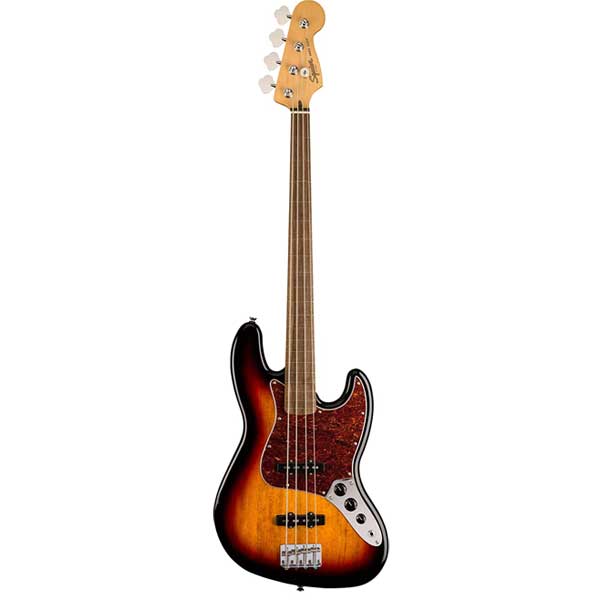
| Estimated Price | $400 |
| Materials | Poplar body, maple neck |
| Fretboard | Indian Laurel |
| Pickup Configuration | 2x Fender-designed Alnico single-coil pickup |
| Scale Length | 34” |
My Review: This fretless model hits my sweet spot. The authentic 1960’s look is just perfect for me, as someone who loves Fender instruments all around. Combining the smooth playability which made it so popular among bassists initially with tonal versatility, this fretless bass guitar is of a quality that belies its affordable price. The controls are simple and allow for good tonal expression.
Key Specs and Features: The body is made out of poplar with a retro tint-gloss finish on the neck. With that, you get a fretless bass with an authentic 1960’s aura. All of the design has been handled by Fender, so you can be sure that the Classic Vibe has been made with due care and attention to detail. There’s no shortage of comfort and playability with the Squier Classic Vibe 60’s bass. The neck profile is C-shaped made out of maple with a scale length of 34”. The fret lines are marked on an Indian Laurel fretboard. You’ll have no problem being accurate with your finger placement. The powerful tone of this fretless bass is largely down to its Fender-designed, dual alnico single-coil pickups. I’m a big fan of Fender’s range of bass guitar pickups, and these particular ones produce a full-bodied warm tone that has an overall jazz bass feel. The 60’s feel of this fretless bass comes from a combination of the vintage-styled, nickel-plated hardware and headstock markings.
Target Customer: A player-friendly bass, carrying the vintage vibe of the old-school Fender basses, this fretless model is an amazing buy. It can work great for players that are just starting on their fretless journey.
Bottom Line: Apart from the vintage design the sound and quality you get from this thing are massive. The Squier Classic Vibe 60’s fretless bass is a tributary model celebrating a decade since it was first produced. Fender again managed to produce an instrument worthy of our time and money.
8. Yamaha TRBX204

| Estimated Price | $300 |
| Materials | Mahogany body, maple neck |
| Fretboard | Rosewood, 24 frets |
| Pickup Configuration | Split-coil, single-coil |
| Scale Length | 34” |
My Review: The thing I like about this Yamaha TRBX204 is that its tone punches way above the price. It has a wide range of sounds that you can create with the tone controls perfect for creating that fat juicy rough tone needed for metal. It fares quite well in live and studio sessions. For the most part, the definition of the tone is great, with crisp trebles and a well-rounded low-end response. The overall quality of the hardware is good and every component does its job more than well.
Key Specs and Features: The shape of the bass is a standard Yamaha design, with a deep cutaway under the neck joint. The full-body single coloring, with several options available for sale, is great since it allows a whole lot of options to the buyer. The body of the guitar is built out of mahogany, a great choice in my opinion. Mahogany gives the bass strong resonance with a thick and full tone. The body is quite sturdy and strong. The bolt-on neck is a standard maple piece with a rosewood fretboard and a very comfortable profile. The overall quality of the hardware is good and every component does its job more than well. It has a set of pretty decent active pickups, the standard P-Bass setup with a single-coil in the bridge position, and a split-coil at the neck. The output is not as strong as with a humbucker but the sound is still powerful. The overall quality of the hardware is good and every component does its job more than well.
Target Customer: It’s affordably priced so it’d be a great beginner bass but it’s a good choice for general use for more advanced players that want to test those muddy metal waters. You might want to eventually consider a pickup swap to something a little more distinctive and wide-ranging but if you are just into the metal there is no need for that. For anybody that is looking for a bass that will last them for a long time.
Bottom Line: This TRBX 204 offers features like an active preamp, classic tonewood construction, and a design that looks great. If you are looking for a relatively future-proof model that will serve well for a long time, I recommend the Yamaha TRBX204. Considering that it is an active bass in this price range, it’s a must buy. A solid quality bass that offers a balanced performance this Yamaha proves again why they are still holding the standard in the industry. Their instruments can adapt and be used in all kinds of settings as proven with this bass.
9. Ibanez AEB10E
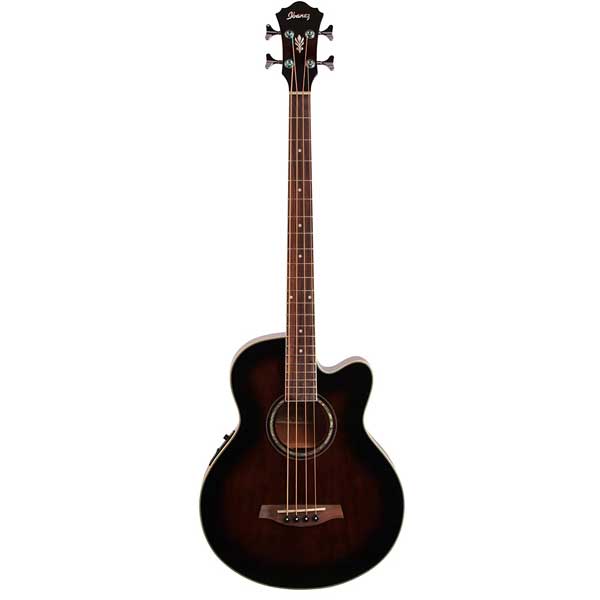
| Estimated Price | $400 |
| Materials | Spruce top, mahogany back and sides, mahogany neck |
| Fretboard | Rosewood, 22 frets |
| Pickup Configuration | Fishman Sonicore pickup and SST preamp |
| Scale Length | 32” |
My Review: Ibanez was always known for bringing great performance and style to the acoustic guitar world. And they did it again with the AEB1OE. When it comes to sound, Ibanez AEB10E punches tangibly above its weight class. We can probably attribute that to a great choice of materials, proper bracing, and that legendary Ibanez know-how. The tone is well defined with plenty of girth in the low range. Mids are present and clear, while trebles come across as punchy. When plugged in Fishman preamp does its thing. You get a very authentic plugged in sound with a good amount of maneuvering space thanks to the onboard EQ. Despite not being a handmade model I’m truly impressed with the Ibanez AEB10E.
Key Specs and Features: No need to talk about aesthetics because it just looks amazing. The concert body design is made out of a solid spruce top and mahogany sides and back. The finish is a beautiful dark stain burst. The neck is also made out of mahogany and it sports pearl inlays, abalone rosette, and pearl binding. Fit and finish are top-notch. The fretboard is made out of rosewood. Ibanez AEB10E features a great set of lockers and a proper rosewood bridge. Ibanez turned to Fishman for the electronics. They have chosen a combination of SST preamp and Sonicore pickup for this build. This combo has been proven to work well.
Target Customer: This bass can serve well as a practice instrument but that would be a waste considering its looks. The sound you get from it can do well in different styles of playing. Both beginner and intermediate players should consider getting this awesome acoustic bass.
Bottom Line: A truly awesome bass, it can attract attention by its looks alone, but when you pick it up its performance shows the true quality of the instrument. If you are looking for a proper mid-range acoustic bass guitar, chances are you won’t find something much better than this.
10. Gretsch G2220 Junior Jet II
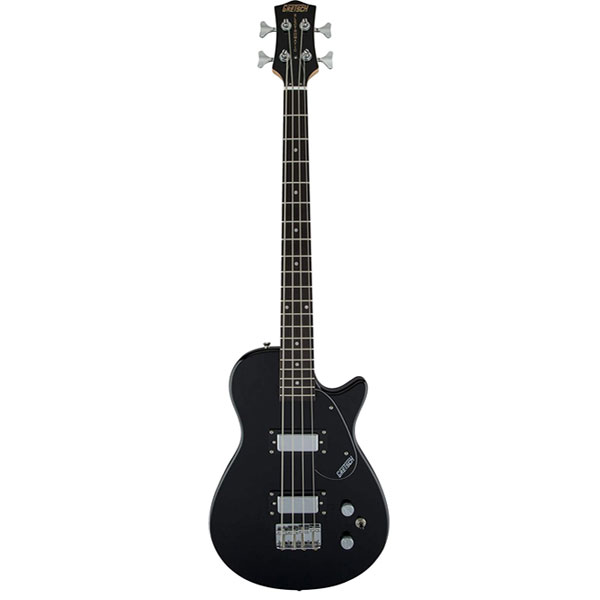
| Estimated Price | $300 |
| Materials | Basswood body, maple neck |
| Fretboard | Rosewood, 20 medium jumbo frets |
| Pickup Configuration | 2x Gretsch mini humbucker |
| Scale Length | 30” |
My Review: Gretsch G2220 Junior Jet II Bass is the bass many players would be surprised with, especially with its versatility. You can comfortably play different music styles and utilize different techniques. The tone you get out of it is perfect for precision work as well as smooth bass lines. The general perception is that short-scale instruments, especially basses, sacrifice some tone for comfort and playability but that is not the case here. The tone from both pickups is clear and bright, the passive pickups do a reasonable job of conveying the tone of the instrument. It has just enough of fatness and punch.
Key Specs and Features: The single-cutaway body shape is made out of basswood. The black gloss-finish fits perfectly with the D-shaped, sleek, and slinky maple neck. It’s easy to navigate, and the set-up is generally very good with no sharp fret ends. The neck is a shorter scale that features a rosewood fretboard with 20 well-placed medium jumbo frets and a Jet style headstock. It comes with a vintage bridge that sports a set of four fully adjustable saddles. All the hardware is chromed, the tuners are accurate and the bridge holds intonation quite well. It has a set of Gretsch mini-humbuckers with a chrome cover on each one. This gives the bass some character. Basic controls, master volume knob, and a tone control knob.
Target Customer: For people who like a simple instrument without all the bells and whistles and are looking for an equally simple tone without too much fuss, the Junior Jet II is not going to disappoint. If you are just starting or you want to try a short-scale, this one is not going to disappoint you.
Bottom Line: A bass with a lot of good qualities, from the built to the sound. If you’re looking for a decent bass with surprisingly good sound but and don’t have much money to work with this bass gives you plenty of space to experiment with. It provides plenty of vintage sounds that will get you excited to play it.
11. Ibanez GSR 200
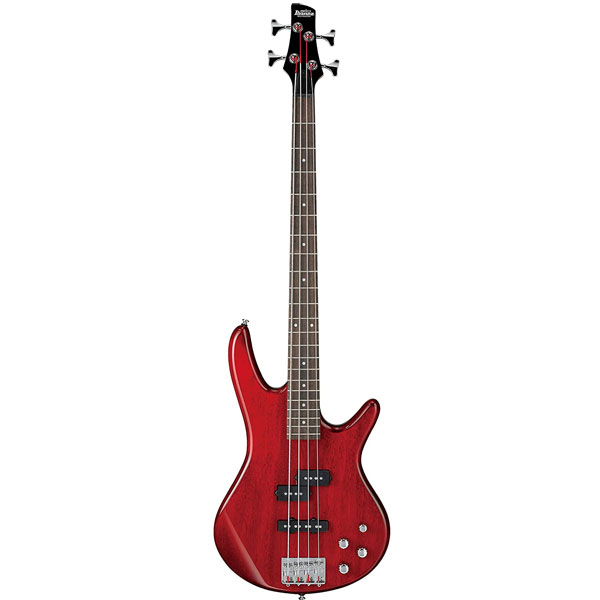
| Estimated Price | $300 |
| Materials | Agathis body, maple neck |
| Fretboard | Rosewood, 22 frets |
| Pickup Configuration | Split-coil, single-coil |
| Scale Length | 34” |
My Review: Ibanez introduced the Soundgear or SR series in 1987. The idea was to build a smooth playable instrument that musicians can put their trust into. This Ibanez bass came as surprise to me considering they decided to put an active set of electronics, unlike most other brands, with the strange pickup set up this bass stands out from the rest in its price range. It is an entry-level bass but still, it provides a wide range of tone shaping, it has a nice warm sound with a good low-end response. For the price range of course there are going to be limitations on what you can do, but still, it fairs quite well in different genres of music. Ibanez tried to make a bass with a little bit of everything which I think is a good thing as that is something quintessential for beginner bass players. You can play around and experiment with the sound.
Key Specs and Features: The body is a smaller size, straightforward, made out of agathis which is quite light and it gives the bass a warm tone with good presence. The body has rounded edges which make it comfortable to hold and play with a bevel in the top corner where your armrests. The thin neck is made out of maple with cool pearl dot inlays on a nice rosewood fretboard. There are 22 frets with a scale length of 34”. It has a standard synthetic nut and a set of die-cast tuning machines. The pickup setup is interesting, one with one split-coil at the neck and one single-coil at the bridge with control knobs for each one and a master volume knob. It comes with active electronics which is rare for this price range. One of the standout features of this guitar is the Phat ll EQ knob which gives you an extra bass boost.
Target Customer: It is an overall great beginner’s bass, with good playability, smooth neck, and design. Somebody would say shorter scale basses are better for beginners which is true, but this bass compensates for that with its light body and frame.
Bottom Line: Great for jamming with friends and building up skill, this bass by Ibanez hits the spot with its qualities in the affordable range of instruments. It’s sturdy, loud, and bassy, everything you would expect from an Ibanez.
Choosing the Right Bass Guitar Under $500 (Buying Guide)
Bass Guitar Neck Types
There are three choices when it comes to bass necks.
Bolt-on neck: The bolt-on is the most popular neck design. The neck is bolted onto the body with nuts keeping it in place so it doesn’t move around. This type of neck offers a great string vibration, good sustain, and great stability. Bolt-on necks are the most common type of necks found on bass guitars.
Set neck: Set necks are a little more difficult to attach, a mortise joint is used to join the neck with the body of the bass. They offer better sustain than bolt-on, they can be found on many high-end guitars.
Thru-body neck: The thru-body necks are the best but also the most expensive and the most difficult to produce. In this case, the neck goes all the way through the body as a solid piece of wood, and then the sides are glued to it, giving the bass the best sustain and stability. They are typically found on expensive custom made basses.
The kind of wood the bass is built from is the heart of its tone. Pickups, electronics will also shape the sound of the instrument but it all begins with the wood, that’s why the material of the neck is very important, in combination with the body of the bass you get a lot of different variations. The most common material used for necks are:
Maple: Sometimes used for the body of the bass, maple is most commonly used for necks. It has a clear bright tone.
Rosewood: An opposite of maple, its softness gives it a warm mellow sound.
Ebony: Harder than maple it provides excellent clarity with amazing high frequencies. Ebony is really good for fretless basses.
Body Types
The main choice when it comes to a bass body is between a solid or hollow body. The solid body is by far the most common, although, the wood that they are constructed from could be anything from maple to swamp ash, and mahogany. The more money you pay, the better quality the wood, and this will make a profound difference to the tone you’ll get out of your bass.
The other option is a hollow body. They are sometimes referred to as semi-acoustic bass guitars, as they have the hollow body of an acoustic, and the pickups of an electric. Hollow bodied bass blues guitars are preferred by jazz and blues musicians, whereas you need a solid body to rock.
The Main Woods Used for Bass Bodies Are:
Maple: Usually heavy and hard, exceptional sustain, and clear sound.
Mahogany: Quite heavy, with medium hardness and density, great sustain and warm sound with emphasis on low-mid and lower-range tones. Victor Wooten has a well know Fodera bass made out of mahogany.
Alder: P-basses are made of, full balanced tone with excellent clarity, warm sound. Famous bass player Jaco Pastorius used to play a Fender bass with an alder body.
Ash: An opposite to alder, ash has a bright sound with plenty of basses and bright treble, several species of ash offer unique differences, usually bright and full sound. Marcus Miller is known to use a jazz bass that has an ash body.
Basswood: Very short sustain, inexpensive.
Take notice when picking the bass for yourself in terms of your physique. A heavier instrument can sound great but also take a toll on your body especially in long term.
Fretboard
The fretboard or fingerboard is where your fingers create the first sound of the bass! The fretboard is a piece of wood glued on top of the neck and it’s the part of the bass that usually has the most amount of wear so harder woods are used for it. Most commonly the fretboard is made out of woods like rosewood or maple. Rosewood is usually brown and has a warm, dark tone while maple is white and has a more percussive sound. The thing to pay attention to is the fretboard radius. In short, the radius is the curvature of a circle of which the small segment is equal to the width of the fretboard. For example, a circle with a 12” radius yields a 12” fretboard radius, which is slightly flatter than a 9.5” radius on a fretboard of the same width, the lower the measurement, the greater the curvature, and vice versa. Why is this important? Because it impacts playability, for example, a bigger radius is better for playing single notes while a smaller is better for chord playing, but it all comes down to personal preference and what best suits your hands.
When you grab the bass you going to notice it has these fret marks on the side of the neck (side dots) and the fretboard. Most basses have them. These things can be really helpful especially when playing in dark and places where there is not much light falling on you. They help you keep your sense of orientation when playing and going up and down the fretboard, the side dots are really useful so you don’t have to twist your neck trying to see. People have started to play around with these fret marks experimenting with different shapes and sizes, a very useful feature indeed.
Pickups
Pickups play an internal role in the sound coming from your bass, their positioning whether they are closer to the neck or the bridge. Closer to the bridge sound is brighter and thinner while closer to the neck the sound gets more warm and full. The same thing stands for whether they are passive or active.
There are different variations on the pickups you can use:
Single-coil: They have one coil wrapped around the magnet giving an often bright and clear sound, a common problem with them is that they can pick up noise and create humming sound. Fender Jazz basses are known to use two single-coil pickups.
Double-coil: Created as a substitute for two single-coil pickups, known as humbuckers they are used to cancel out the humming sound. They have more output than single-coils and have more high frequencies.
Split coil: You split a humbucker in half and you get a split-coil pickup, usually used on P-basses.
Weight
This will depend on the material and size of the bass guitar. Most bassists play with the bass strapped around your neck. That means you’ve got to be comfortable with the weight. If you choose a lighter bass, though, you could find that the tone isn’t as deep and sustained as a heavier bass.
Bridge
There are three common types of bridges, which is the place where the strings terminate on the guitar. It is a matter of taste as to whether you prefer a through-bridge, a string-through-body, or a bridge and tailpiece combination.
Each tends to work well. It’s more important that you choose a bridge that is bigger and weightier, as you’ll get better sound out of your bass.
Scale Length
The scale length refers to the distance between the nut and the bridge. Why it’s important because it impacts the playability and the sound of the instrument in a big way. It affects the quality of the tone you get from the strings, the lower the pitch the longer the strings. The standard these days is 34” which we call “long-scale” basses but there are also short (30-32”), medium (32-34”), and extra-long (36” plus) scale basses. Not all scale lengths are the same and there aren’t any firm rules on this between bass and strings manufacturers so it’s something you should pay attention to. A lot of players have a problem with choosing their string lengths which is why you need to know your scale length.
Truss Rod
This is a rod that is found in the neck of the bass guitar. It can become bowed or even twisted because of the tension of the thick bass strings. A good bass will have an easily adjustable truss rod.
Appearance
Let’s not forget one of the most basic elements of a bass. That’s the way it looks. You have to choose a body-type, color, and style that suits you, especially if you have dreams of getting up on stage with your bass guitar. The best thing you can do here is to look around at what’s available and work out what you think would look best strapped over your shoulders. But this is the least important specification. Sound and solidity are far more important.
Pick one that Sounds Good to Your Ears
Different bass guitars produce different tones because of their construction, materials, and electronics, so if you want to see which one delivers the tone that you want, you have to listen.
The overall output can be influenced by the amps used as well as the audio and EQ settings, however, so make sure to factor those in. Nothing beats being able to play bass in person to see how it sounds and feels in your hand of course, but if the music stores you have access to don’t have the model you’re interested in, demo videos and bass reviews are the next best thing.
If the bass sounds like a chorus of angels to you, that’s a good sign you’re making the right choice.
Pick the one you find attractive
Sometimes all it takes is just a glance to know if a bass guitar is ‘The One.’ What you find aesthetically pleasing in a bass can be influenced by your style and your musical inspirations.
An added benefit of choosing a bass guitar that makes your head turn is that it can motivate you to keep on playing even if you’re not particularly up for it. If you’re experiencing some doldrums in your career or bass lessons, having an instrument you can’t take your eyes and hands off can spur you into action. You will practice more or simply just noodle with your bass – and come up with a catchy new riff.
Holding something you consider precious will inspire you, get you in the mood to play and make you look forward to becoming the best musician you can be. So by all means choose the bass guitar that makes your heart go thump!
Should you choose a four-string or a five-string bass?
The standard bass comes with four strings. It is recommended to begin with a four-stringer because it is easier to learn on and gives you all the versatility you need when first beginning to play. The more strings you have, the more range you will be able to get out of the instrument, that’s why advanced bassists like five-string or six-string bass guitar. It also means you have a wider neck, so your hand size must be considered.
The decision to choose a 4-string or 5-string bass often depends on the music you play. Some players tend to gravitate to 5-string bass guitars for metal because of the low-B string. Modern extreme metal guitarists often tune their instruments down several steps or play 7-string guitars, and a 5-string bass just makes things easier.
Jazz and some rock players might prefer an extended-range bass to make playing scales and chords a little easier. You don’t have to switch hand positions as often, leading to more efficient playing. For most traditional bassists, a 4-string is just fine. You can still tune down if necessary. In fact, for bassists who haven’t quite got the hang of the instrument I typically recommend a 4-string.
The choice is yours and there is no wrong answer. The highest four strings on a 5-string bass are the same as on a regular 4-string, so it’s not like your missing something by going with a five. However, they usually have a longer scale, and of course a wider neck, so there’s also a different feel.
Passive or active pickups for bass guitar?
I like both and think both can be used for just about any genre. The advantage of active electronics is in the control you have at your fingertips right on the bass itself. They are super versatile, and you can dial in tones for just about any genre you can think of. They are also typically higher output. If you plug into an amp it’s not quite such a big deal, but if you run directly you might appreciate the control that active electronics afford. On the other hand, passive basses tend to sound more natural to me. Of course, you can dial in an active bass with a lot of warmth, but I feel it lacks the natural, woody sound you get with lower-output passive pickups.
A few of the basses on this list include active EQ. Powered by one (or sometimes two) 9v batteries, these circuits give your signal a hefty boot up the backside. If you are looking to play some slap bass or get mean low frequencies for some metal playing, go active! It is an affordable option.
If you’re into blues, classic rock, or generally more vintage sounds, a passive bass may be a better choice. Some say passive instruments have more character, but I’ll leave that topic for another time. Staying on the vintage theme, you may like to consider a short-scale bass. In general, what they can lack in the low end they make up for with a punch in the lower mids. Again, it depends on what music you’re into.
Finally, there are considerations for more technically adept players, too. Top fret access may be vital if you regularly venture up to the dusty end, but so also is the fretboard radius. A flatter (higher radius) ’board generally makes speedy licks a bit easier. That’s just my opinion, based on my experience. Like a lot of things, it’s a personal preference. If I have to choose, I’d say I prefer active basses for metal, especially when playing with a pick. I’d prefer passive bass for rock.
Experiment with both and see what you think.
Why are There a Different Number of Strings?
The first electric bass guitar that was ever produced was created with four strings and for a long period, that’s all there were, were four-string bass guitars. The reason why there are more strings on a bass guitar is to add more range to the instrument. It is simple, having a larger range means that musicians can play further into the bass range or even the treble range. Another added benefit of having a bass guitar with more than four strings is that your hands don’t have to work as hard shifting around the neck of the bass guitar as much.
Five and six-stringed guitars began to take off in the 1980s, as bassists were in huge competition with electric keyboards. A lot of bass guitarists were being replaced in bands by computers and keyboards, as they had more of a range than a standard four-string bass guitar did. To keep up with the competition, bassists began to add more strings to their guitars, to have a broader range. The fifth string that bass players added allowed the musicians to reach further into the bass range, while the sixth string allowed musicians to reach into the treble range with more ease.
What scale is best for me?
Short-scale bass guitars are, as the name suggests, much smaller. Choosing a model that is a short scale is ideal for smaller hands. That makes them ideal for younger bassists. If you’re a child and a beginner, you would probably be best selecting a short-scale bass. If you are older or have large hands, then the regular scale would be a better choice.
Do I want an electric or an acoustic bass?
It entirely depends on what sort of music you want to play on your bass. The electric bass means it is amplified, so if you’re playing with a band, then you need an electric bass. Well, that’s unless you’re a low-fi, acoustic band. Then it would be a much better idea to choose an acoustic bass guitar.

My name is Chris and I’ve had a passion for music and guitars for as long as I can remember. I started this website with some of my friends who are musicians, music teachers, gear heads, and music enthusiasts so we could provide high-quality guitar and music-related content.
I’ve been playing guitar since I was 13 years old and am an avid collector. Amps, pedals, guitars, bass, drums, microphones, studio, and recording gear, I love it all.
I was born and raised in Western Pennsylvania. My background is in Electrical Engineering, earning a Bachelor’s degree from Youngstown State University. With my engineering experience, I’ve developed as a designer of guitar amplifiers and effects. A true passion of mine, I’ve designed, built, and repaired a wide range of guitar amps and electronics. Here at the Guitar Lobby, our aim is to share our passion for Music and gear with the rest of the music community.

